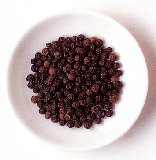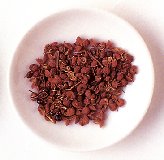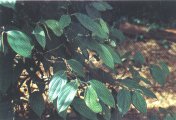Pepper
http://www.100md.com
《e Natural Health Center》
 |
 |
 |
 |
Flavorings
Pepper
Latin:
Fructus Piperis
Origin:
Pepper refers to any of a great number of plants of the nightshade family, Solanaceae, notably Capsicum annuum L. (Sweet Pepper), Capsicum frutescens L. (Tabasco Pepper); and Zanthoxylum piperitum (L.) DC. (Sichuan Pepper or Japanese Pepper), of the family Rutaceae. It is extensively cultivated throughout tropical Asia and equatorial America for their edible, pungent fruits.
, http://www.100md.com
Peppers, which have been found in prehistoric remains in Peru, were widely grown in Central and South America in pre-Columbian times. Pepper seeds were carried to Spain in 1493 and from there spread rapidly throughout Europe.
The genus Capsicum comprises all the varied forms of fleshy-fruited peppers grown as herbaceous annuals--the red, green, and yellow peppers rich in vitamins A and C that are used in seasoning and as a vegetable food. Hot peppers, used as relishes, pickled, or ground into a fine powder for use as spices.
, 百拇医药
In addition to the cherry (Cerasiforme group) and red cluster (Fasciculatum), these hot varieties, which are red when mature, include the tabasco (Conoides), which is commonly ground and mixed with vinegar to produce a hot sauce, and the long "hot" chili and cayenne (Longum), often called capsicums.
Cayenne pepper, said to have originated in Cayenne in French Guiana, is one of the spices derived from these peppers and is produced in many parts of the world.
, http://www.100md.com
The mild bell or sweet peppers (Grossum) have larger, variously colored but generally bell-shaped, furrowed, puffy fruits that are used in salads and in cooked dishes. These varieties are harvested when bright green in color--before the appearance of red or yellow pigment--about 60 - 80 days after transplanting.
Pepper plants are treated as tender summer annuals outside their native habitat. They are propagated by planting seed directly in the field or by transplanting seedlings started in greenhouses or hotbeds after six to ten weeks.
, 百拇医药
Pepper is used in traditional Chinese medicine as a warming herb. In China, pepper is mainly produced in the provinces Hainan, Guangdong, Guangxi, Yunnan, etc. Harvested at the end of autumn to spring of the next year when the fruit becomes red or dark green, it is dried in the sun, resulting in black pepper; or picked and reaped when the fruit turns red, soaked in water and dried in the sun after the pulp is rubbed away, making white pepper; then pounded for use when raw.
, http://www.100md.com
See also Herbs, Herbs for Warming the Interior, Pepper; and Food, Vegetables, Chili Pepper; Food, Flavorings, Prickly Ash.
Properties:
Pungent in flavor, hot in nature, it is related to the stomach and large intestine channels.
Functions:
Warms the middle-jiao and keeps the adverse qi flowing downward, clears away phlegm and toxic materials.
, http://www.100md.com
Due to its hot nature, pepper is good for expelling evil cold and warming up the body interior, especially when cold phlegm accumulates and stagnates in the body.
Pepper is also a stomachic when one's stomach suffers a cold invasion and is in need of warming. It also relieves pain, sends down adversely rising qi, as well as yields some antipyretic (reduces fever) action.
When used externally, it can treat skin and external diseases, poisonous snake or dog bites, and can also be used to remove poisonous quality of food.
, http://www.100md.com
Applications:
1. To treat cold pain in the abdomen, vomiting and diarrhea due to stomach-cold:
a) Abdominal pain and vomiting due to stomach-cold:
Pepper can be ground alone into powder and stewed together with pig stomach or used with lesser galangal (Rhizoma Alpiniae Officinarum), long pepper (Fructus Piperis Longi), etc., for oral administration.
, 百拇医药
Or, immerse some pepper in vinegar. Then take it out and dry under sunlight. Repeat the process 7 times. Grind the pepper into powder. Administer 3 g, twice daily.
b) For diarrhea due to deficiency-cold in the spleen and stomach:
Pepper can be used together with evodia fruit, largehead atractylodes rhizome (Radix Atractylodis Macrocephalae), etc., and it can also be ground alone into powder for application onto the umbilical region.
, http://www.100md.com
2. To warm up cold of wind-cold type:
Prepare pepper and clove, each 3 g. Grind them as powder. Use 2 white bulbs from Chinese onion and pound, then mix with the prepared powder. Put a small mass onto the palm. Close both palms together and put the closed hands in between the two thighs until one sweats.
3. To treat epilepsy:
Pepper can be ground together with long pepper (Fructus Piperis Longi) in an equal amount for oral administration, or the pepper is placed in turnip and dried in the air and ground into powder for oral administration in the manner described in the book 'Recipes for Emergency'. In addition, it can induce appetite and digestion if used as a seasoning.
, http://www.100md.com
4. For dyspepsia (indigestion) in children:
Grind 1 g white pepper as powder and 9 g glucose powder. Mix them together. Administer 0.3-0.8 g (<1 year old), 0.5-1.5 g (< 3 years old), three times daily, 1-3 days for a therapeutic course.
5. For prolapse (sinking) of stomach:
Clean a pig's or sheep's stomach (about 500 g) to which 1.5 g white pepper is added. Simmer with slow fire until well done. Consume the stomach and soup.
, 百拇医药
Dosage and Administration:
2-4 g.
Used either as an ingredient of boluses or powder or as seasonings in decoction for internal use. When grinded into powder for oral administration, a dosage of 0.5-1 g is recommended. Use an adequate amount externally.
Cautions on Use:
For people used to have flaring up of inner fire, manifesting red eyes, sore throat or thirst, pepper is contraindicated.
, 百拇医药
Reference Materials:
'The Newly-Revised Materia Medica':
"Sending down adversely rising qi, warming the spleen and stomach, resolving phlegm and removing wind-cold from the internal organs."
'The Compendium of Materia Medica':
"Warming the stomach and intestines."
"Regurgitation due to cold-dampness, distention of the deficiency type, cold accumulation, cold inflammation and floating heat of the teeth with pain."
, 百拇医药
Toxic or Side Effects:
Modern Researches:
Pepper contains piperine, chavicine, piperonal, piperanine, cryptone, caryophyllene oxide, alcohols, and volatile oil.
Pepper has wind-dispelling and stomach-strengthening effects if taken orally. The piperine that it contains has obvious anticonvulsant and tranquilizing effects. Pepper can dilate the blood vessels of the skin if taken orally, giving rise to warm and hot sensations.
, 百拇医药
According to 'Eating Your Way to Health', twenty-four cases of healthy people were researched by keeping 0.1 g pepper under the tongue. The blood pressure was examined before and after the experiments. It was discovered that there was temporary rise of blood pressure (18.1 mmHg for systolic and 13.1 mmHg for diastolic pressure) with recovery to pre-examined levels 10-15 minutes later. There was no change in pulse rate. Pepper also stimulates the involuntary movements of isolated intestinal and uterine muscles of animals in vitro., 百拇医药